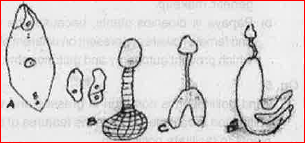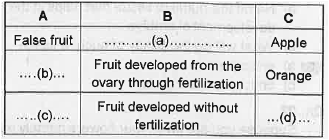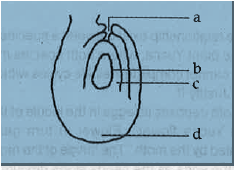Complete Solutions to EXERCISE of chapter SEXUAL REPRODUCTION IN FOLLOWING PLANTS of Class 12 book with complete answers and questions
| Class 12 | BIOLOGY |
| Chapter | SEXUAL REPRODUCTION IN FOLLOWING PLANTS |
| MAXIMUM PUBLICATION | EXERCISE |
| Number Of Questions | 100 |
| Academic Year | 2023-24 |
Types of pollination in Commelina is
02:21View SolutionWhen pollen is transferred from anther of a flower to stigma of the another flower of the same plant, it is referred to as
01:26View SolutionFor plant breeding purposes : Pollens are stored at `-196°c` . What is the purpous behind it?
01:38View SolutionPollen tubes enters the embryo sac through
01:44View SolutionIn flowering plants, fertilization occur in
00:37View SolutionThe source of food for developing embryo is
01:47View SolutionOut of megaspre tetrad, the functional megaspore is
02:07View SolutionHow many megaspore mothe cell are produced in a nuclellus
01:24View SolutionDuring the monosporic development of embryo sac the nucleus of the functional megaspore divides
View SolutionCross pollination has the advantage of
02:24View SolutionUnisexual flower prevent
00:54View SolutionThe function of the filiform apparatus is
00:51View SolutionFind the odd one
02:00View SolutionChoose the correctly matched pair
02:09View SolutionChoose the correct answer.
The layer of microsporangium that nourishes the developing pollen grains is:
Endothecium
Tapetum
Middle layer
Epidermis01:33View SolutionA typical angiosperm embryo sac at maturity is.
02:31View SolutionThe process of formation of fruits without fertilization is called
01:52View SolutionIdentify the wrong statesments regarding post-fertilization development.
02:22View SolutionDicot embryo consists of :
radicle and plumule
radicle, plumule, cotyledons and sometimes endosperm.
radicle and plumule, cotyledons and tegmen
radicle and plumule, cotyledons tegmen ,testa01:30View SolutionThese process are necessary for the complete development of male gametophyte from pollen mother cell.
One meiotic and two mitotic devisions
One meiotic cell division and one meiotic cell division
Two meiotic cell division and one mitotic cell division
Two meiotic cell division02:36View SolutionA bilobeddithecus anther has 100 microscope mother cells per micro sporangium. How many male gametophytes this anther can produce?
02:17View SolutionAn anther with malfunctioning tapetum often fails to produce viable male gametophytes. Give one reason.
01:51View SolutionPollen grains are well preserved as fossil for many years due to some characteristics
Give reasons01:53View SolutionPollen grains are well preserved as fossil for many years due to some characteristics
Give reasons01:53View SolutionOne time fertilization is the characteristics feature of majority of plants but angiosperm shows two times of fertilization.
Two fusion occurs are different. Name it and write down the number of nuclei involved in such process.01:20View SolutionOne time fertilization is the characteristics feature of majority of plants but angiosperm shows two times of fertilization.
Name the products and ploidy03:20View SolutionCommelina, viola and oxalis that carries both chasmogamous and cliestogamous flowers.
Find out the main differences between them.01:45View SolutionCommelina, viola and oxalis that carries both chasmogamous and cliestogamous flowers.
Give the significance of Cliestogamy02:13View SolutionGeitonogamy is a functional cross pollination but not genetically. Justify?
(b) In Papaya, Autogamy and Geitonogamy do not occur. Give reason.03:51View SolutionWind pollination is common in grasses and water pollination in vallisneria. Give the features of these plants to facilitate pollination.
06:41View SolutionIn most plants continuous self pollination leads to inbreeding depression while in others certain devices that help to discourage self pollination. Give any four devices.
04:18View SolutionThe micropyle remains as a small pore in the seed coat. What is its role?
00:57View SolutionDraw the diagram of a typical dicot embryo and label the parts like plumule , cotyledons , radicle and root cap.
02:02View SolutionObserve the developmental stages given below and answer the following.

Name the process.01:36View SolutionObserve the developmental stages given below and answer the following.

Label the stages A,B.C,D02:04View SolutionApomictic seeds are important in agriculture. Do you agree? Give reason.
01:43View SolutionGive the technical terms for the following
Produce seeds without fertilization.02:19View SolutionGive the technical terms for the following
Persistent nucellus01:46View SolutionEmasculation may not be necessary. Yet bagging is necessary. Justify giving the condition when such a thing can happen.
02:23View SolutionBanana is a true fruit and also a parthenocarpic fruit. Justify.
02:14View SolutionArrange the following terms in the correct development sequence :
Pollen grain, sporogenous tissue, microspore tetrad, pollen mother cell.02:59View SolutionPollen grains of many plants are found to be allergic.
Give examples.02:48View SolutionSome peoples live in area are subjected to allergic disease due to pollen grains.
(b) Give an example for two disease?01:39View SolutionTypical angiosperm embryo sac is 7 celled and 8 nucleate. This condition occurs due to the development of megaspore mother cell.
a) How many meiotic and mitotic divison takes place?
b) What you mean by monosporic development?03:30View SolutionPollen allergy that causes chronic respiratory disorders in men like asthma and bronchitis. Name the causative plant.
01:00View SolutionSome pollen grains cannot germinate on stigmatic surface due to the loss of viability.
Name the factors influence the viability of pollen.02:02View SolutionSome pollen grains cannot germinate on stigmatic surface due to the loss of viability.
How do the pollen grains can keep up for many years.01:20View SolutionPollen tube growth occurs through the stylar region and reach micropyle of ovule. Name the special cellular thickening that guides Pollen tube.
01:43View SolutionPollen grains of many plants are found to be allergic.
Do they have any benefits other than the involvement in reproduction. Explain.01:17View SolutionPollen grains of many plants are found to be allergic.
Give examples.02:48View SolutionZygote development leads to the formation of embryo.
Name the nutritive tissue that helps in the development of embryo.01:24View SolutionZygote development leads to the formation of embryo.
What will be the ploidy of such a tissue.01:32View SolutionSuppose you are the given four flowers namely maize, vallisneria, sunflower and zostera.
(i) State the mode of pollination in each flower.
(ii) Differentiate between cleistogamous and chasmogamous flowers.05:09View SolutionA close relationship exist between a species of moth and the plant Yucca, where both species moth and Yucca cannot complete their life cycles without each other. Justify it.
04:32View SolutionCoconut and groundnut are oil yielding crops. Point out the difference in the structure of seed.
02:26View SolutionSeeds are formed in angiosperms when male and female gametes get fused. But in some plants seeds are produced without the fusion of gametes.
Name the process.02:50View SolutionSeeds are formed in angiosperms when male and female gametes get fused. But in some plants seeds are produced without the fusion of gametes.
Comment01:37View SolutionIn market, seedless grapes are high priced than seeded grapes. Give the method used to develop this by farmer.
01:47View SolutionPlant A with combined desired characters that are inherited from parents. Plant B with desired characters are pure. Find out the types of pollination leads to accurance of characters in both A and B.
01:57View SolutionIf the diploid chromosome number of a plant is 24. Find out the number of chromosomes in synergid , Antipodal and endosperm.
02:06View SolutionPollination is aided by biotic and abiotic agents. Identify the type of pollination in Vallisneria, coconut and grass.
02:20View SolutionGive the technical terms for the following
Produce seeds without fertilization.02:19View SolutionGive the technical terms for the following
Persistent nucellus01:46View SolutionGive the technical terms for the following
Cotyledons of grass family01:32View SolutionGive the technical terms for the following
Protective sheath of radicle.02:47View SolutionWhy do you think the zygote is dormant for some time in a fertilized ovule?
02:32View SolutionIn some plants self pollination is prevented by genetic mechanism of either pollen or pistil.
Name the process.01:49View SolutionIn some plants self pollination is prevented by genetic mechanism of either pollen or pistil.
Why does such process not lead to seed formation?02:40View SolutionIf one can induce parthenicarpy through the application of growth substances, which fruits would you select to induce parthenocarpy and why?
03:22View SolutionEmbryosac or female gametophyte of angiosperm is 7 celled and 8 nucleate.
How many haploid cells are present in micropylar and chalazal part of female gametophyte of a flowering plant? Name them.03:28View SolutionIf you squeeze a seed of orange, you might observe many embros of different sizes. How is it possible?
03:01View SolutionIf the chromosome number of plant species is 16. What would be the chromosome number and ploidy level of
microspore mother cell01:46View SolutionIf the chromosome number of plant species is 16. What would be the chromosome number and ploidy level of
microspore mother cell01:46View SolutionObserve the flow chart given below. Fill in the blank 1 and 2. Write the relevance of the process indicated as 1.
 03:48View Solution
03:48View SolutionApple and mango are fruits. But they are formed in different ways. How are they formed?
01:59View SolutionThe synergids have special cellular thickening. Name the thickening and write its function.
02:09View SolutionAnalyse the table and fill in the blank.
 02:39View Solution
02:39View SolutionObserve the figure given below. Label the parts a,b,c and d.
 02:29View Solution
02:29View SolutionThe embryo sac development in majority of flowering plants is monosporic development. Explain this type of embryo sac development.
02:07View SolutionSelf incompatibility and dioecious condition are two devices for discouraging self pollination in plants. Explain the two.
01:50View SolutionPeculiarities of certain parts of the ovule are given below. Name the parts.
Protective envelops of the ovule.01:24View SolutionPeculiarities of certain parts of the ovule are given below. Name the parts.
Stalk of the ovule01:06View SolutionPeculiarities of certain parts of the ovule are given below. Name the parts.
The layer of cells within the integuments.01:19View SolutionPeculiarities of certain parts of the ovule are given below. Name the parts.
Junction between ovule and funicle.02:28View SolutionGeitonogamy and xenogamy are two types of pollination. Differentiate between the two.
02:00View SolutionThe inner most wall layer of microsporangium is tapetum. It is multinucleate. Justify the statement.
01:59View SolutionPeculiarities of two types of seeds are given below. Identify the two types of seeds and give example for each.
Endosperm completely used by embryo.01:37View SolutionPeculiarities of two types of seeds are given below. Identify the two types of seeds and give example for each.
Endosperm not completely used by embryo.View SolutionThe embryo of monocotyledons and dicotyledons show difference in structure. Explain the structure of dicot embryo.
02:55View SolutionOccurrence of more than one embryo in a seed is called polyembryony.
Give two examples of polyembryony.02:26View SolutionOccurrence of more than one embryo in a seed is called polyembryony.
How does polyembryony occur?03:18View SolutionMature pollen grain has a vegitative cell and a generative cell. Write the peculiarities of the two cells.
02:20View SolutionEndosperm development precedes embryo development. Explain the development of endosperm.
04:11View SolutionGeitonogamy is similar to autogamy. Justify this statement.
02:20View SolutionApomixis is an asexual form of reproduction, that mimics sexual reproduction. Substantiate this statement.
02:27View SolutionObserve the relationship between the first two terms and fill in the blanks.
Exine: Sporopollenin, Intine : …….01:43View SolutionObserve the relationship between the first two terms and fill in the blanks.
Pistils fused : syncarpous, Pistils free : ………03:16View SolutionObserve the relationship between the first two terms and fill up the blanks
Zygote : Diploid nucleus
Endosperm : _________01:42View SolutionPollen grains in angiosperms are not motile. They have to be carried to the stigma by external agents.
Name the process of transfer of pollen grains.02:33View SolutionPollen grains in angiosperms are not motile. They have to be carried to the stigma by external agents.
Write the name of three such agents.03:12View Solution
EXERCISE questions and complete solutions for chapter SEXUAL REPRODUCTION IN FOLLOWING PLANTS of MAXIMUM PUBLICATION of Class 12
